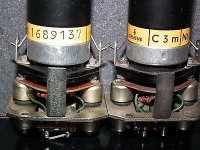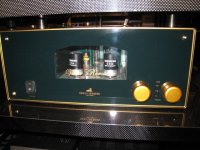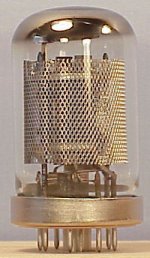Hello,
read about the microphonic problems with Siemens C3m tubes and there were special damped sockets for this tube available.
Does someone have experiences first hand on this topic? Want to use the tube in the output stage of a line pre.
Will it be necessary to build extra shock absorber sockets for the tubes?
read about the microphonic problems with Siemens C3m tubes and there were special damped sockets for this tube available.
Does someone have experiences first hand on this topic? Want to use the tube in the output stage of a line pre.
Will it be necessary to build extra shock absorber sockets for the tubes?
Attachments
Last edited:
Good luck getting a rubberized Loctal base , I have used B9A bases that were mounted on rubber but not B8B.
You could use tube dampers but that's a controversial subject in itself guaranteed to start arguments.
You could use tube dampers but that's a controversial subject in itself guaranteed to start arguments.
Rubber sockets were used for tubes that were mounted in control systems for cannons all to withstand strong vibrations and g-forces from the fire. C3m tubes do well without those sockets.
Shindo Labs are using this tube without any precautions but in a stiff metal sheet tube amp housing. Will that be sufficient, I mean, those are only line level output tubes, not employed in phono sections?
Another option is to mount the two loctal sockets on an extra piece of 2mm metal sheet which is decoupled from the ground plate by using 5mm rubber isolation feet.
Another option is to mount the two loctal sockets on an extra piece of 2mm metal sheet which is decoupled from the ground plate by using 5mm rubber isolation feet.
Attachments
Last edited:
What this is is more a mechanical engineering problem than an electronic one.
As such this type of problem has been discussed for many decades by those designing turntables for vinyl records .
My old Dais deck has thick rubber under the suspension springs to damp resonances, what you propose has already been done to good effect in the hi-fi equipment world so it works.
One guy sat his equipment on thick rubber and I put my Cyrus XTSE+ on three slightly hard rubber mounts removed from a turntable.
You can go OTT in this business but ---if it works for you----.
As such this type of problem has been discussed for many decades by those designing turntables for vinyl records .
My old Dais deck has thick rubber under the suspension springs to damp resonances, what you propose has already been done to good effect in the hi-fi equipment world so it works.
One guy sat his equipment on thick rubber and I put my Cyrus XTSE+ on three slightly hard rubber mounts removed from a turntable.
You can go OTT in this business but ---if it works for you----.
I find it a little hard to believe that a tube made for use by the German Post telephone system in repeater amplifiers is by default microphonic. I did a search on Google and yes, there are lots of posts talking about problems with it but it's also interesting that both the Tube Depot and JACmusic say the opposite. To quote the Depot site "If you want one of the quietest and lowest microphonics tube on the planet, this is your chance." I would think that if it were untrue they'd get enough complaints from unhappy buyers to make them delete the statement.
I had to deal with microphonic tubes years ago and was helped by some posts (one here) by Jeremy Epstein where he talked about oscillation being the underlying factor that made some tube's microphonics a problem.
As for isolation mounting , I would mount the socket on a board and underhang it using silicone rubber computer fan fasteners. Make the hole in the supporting plate a little large and you get better air flow as well.
I had to deal with microphonic tubes years ago and was helped by some posts (one here) by Jeremy Epstein where he talked about oscillation being the underlying factor that made some tube's microphonics a problem.
As for isolation mounting , I would mount the socket on a board and underhang it using silicone rubber computer fan fasteners. Make the hole in the supporting plate a little large and you get better air flow as well.
Thanks for your hints. I have to admit that performing the tock-test right at my ear, this Siemens C3m of mine is dead quite. And I mean, if something is supposed to vibrate inside a tube, it could easily be heard with this test.
I'll mount the two tubes on a separate, rubber isolated platform inside of the very stiff metal sheet housing.
I'll mount the two tubes on a separate, rubber isolated platform inside of the very stiff metal sheet housing.
Maybe a very stiff metal (I guess you mean steel) housing is not the best for C3m. Maybe an aluminium casing and/or a separate subchassis isolated with rubber grommets are a more optimal solution.
Last edited:
Thats why those C3m become an isolated rubber damped platform inside of the main parts plate. I never use aluminum for housing the gear. It was never used by famous tube amp companies in the good old times and its too weak for building a 15-20 Kg. stereo tube preamp. Shindo even refuses to use aluminum, too.
That also counts for titanium 🙂 that also was not used by famous tube amp companies in the past (if that is important). Anyway, 15 to 20 kg is indeed heavy.
Better try yourself what suits best with available materials instead of trusting Shindo or whatever manufacturer. Before you know it you are copying a design and also its quirks 😀
In the stuff I built wood and aluminium always come out better than steel. Both are easier to work with as a bonus.
Better try yourself what suits best with available materials instead of trusting Shindo or whatever manufacturer. Before you know it you are copying a design and also its quirks 😀
In the stuff I built wood and aluminium always come out better than steel. Both are easier to work with as a bonus.
Last edited:
That explains the vibrato in German telephone calls in the past. The tubes were however not easily overdriven.
Titanium generates nice sparks when tooled with a dremel, ask your dentist for that fact. Not first choice for tube amp housing.That also counts for titanium 🙂 that also was not used by famous tube amp companies in the past (if that is important). Anyway, 15 to 20 kg is indeed heavy.
Better try yourself what suits best with available materials instead of trusting Shindo or whatever manufacturer. Before you know it you are copying a design and also its quirks 😀
In the stuff I built wood and aluminium always come out better than steel. Both are easier to work with as a bonus.
But this mesh anode can be the very reason for the tendency of mechanical ringing.
C3m is a mesh anode tube.
It's theoretically a little bit sensitive to vibration, than its cousin C3g.
no, it is only a screen around the anode.
Please explain why a premium material, cost not taken into account, can not be first choice for a chassis?! I did not suggest to use a Dremel, this was also not done in the past by famous tube amp companies (ok, bad joke).
Nobody would use a Dremel for cutting titanium, plasma and water-jet cutting can be used. I for sure would love to have a non corroding material for a casing that is lighter and stronger than steel. My suggestion was not serious but so is the assumption that only materials should be used that were traditionally preferred (probably with low cost being THE decisive factor). After some thinking I like the idea of using titanium. As a technician I found it hard to believe but I was demonstrated a few times that ferro chassis have a detrimental effect on sound quality.
Uh oh....
Nobody would use a Dremel for cutting titanium, plasma and water-jet cutting can be used. I for sure would love to have a non corroding material for a casing that is lighter and stronger than steel. My suggestion was not serious but so is the assumption that only materials should be used that were traditionally preferred (probably with low cost being THE decisive factor). After some thinking I like the idea of using titanium. As a technician I found it hard to believe but I was demonstrated a few times that ferro chassis have a detrimental effect on sound quality.
Uh oh....
Last edited:
Every time the dentist has to shorten the newly implanted pivot tooth, he uses a dremel- like tool. Its nothing that never happens, it happens every time in a dentist life.
Maybe some sort of High End audio company will come to market with such titanium housing instead of steel. For me its not an option. Way too pricey and a pain in the *** when it comes to build with.
Maybe some sort of High End audio company will come to market with such titanium housing instead of steel. For me its not an option. Way too pricey and a pain in the *** when it comes to build with.
If it is good to use for teeth then a casing could be made of it as well.
I don't see the point that a dentists experience has impact on the use of the material for a casing?! I just want to make clear that sturdy believing the old material choices are best will not lead to innovation. If the automotive industry would think like that engines would still be built of cast iron.
Years ago I saw a casing for a CD player that was CNCed from a solid piece of ebony....it was beautiful.
I don't see the point that a dentists experience has impact on the use of the material for a casing?! I just want to make clear that sturdy believing the old material choices are best will not lead to innovation. If the automotive industry would think like that engines would still be built of cast iron.
Years ago I saw a casing for a CD player that was CNCed from a solid piece of ebony....it was beautiful.
Last edited:
- Home
- Amplifiers
- Tubes / Valves
- How microphonic are Siemens C3m tubes?


